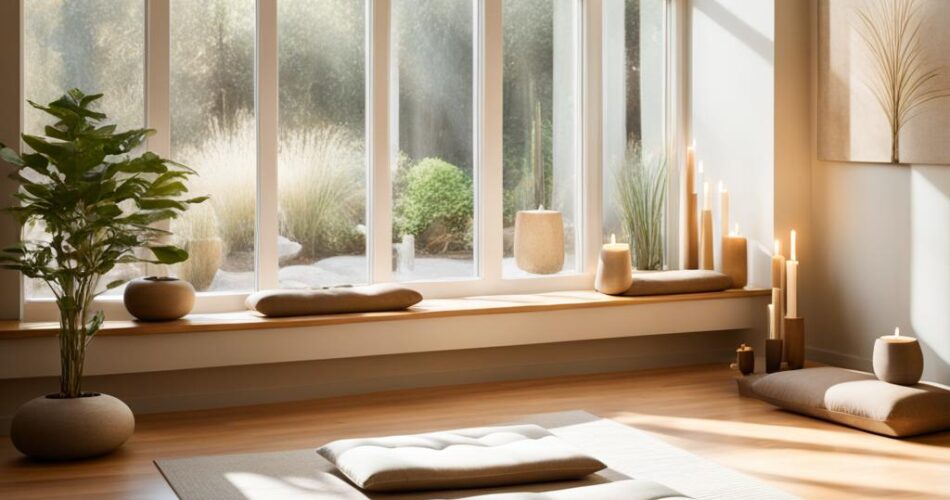Imagine a space where stress melts away and tranquility reigns supreme. That’s the power of a well-designed meditation room. More people are now making their own serenity sanctuaries at home. Meditation practices in the U.S. tripled between 2012 and 2017, showing a growing need for personal relaxation.
Your zen den doesn’t have to be big or fancy. It can be a cozy corner or a special area with things that mean a lot to you. Think of postcards, photos, candles, and personal mementos that touch your soul. This space becomes your go-to for rest and renewal, offering a safe haven when life gets busy.
Creating a meditation room is more than just making it look nice. It’s a promise to yourself for self-care and inner peace. Studies show that having a dedicated space can cut sleep time for insomniacs by 50%. That’s the power of a well-crafted peace pavilion in your own home.
Size doesn’t matter when it comes to your meditation space. What’s key is that it suits your needs and creates a calming vibe. Whether you’re a pro at meditating or just starting, your personal serenity sanctuary can greatly improve your mental health.
Key Takeaways
- Meditation practices in the U.S. have seen significant growth
- A dedicated meditation room can improve sleep quality
- Personalize your space with meaningful objects
- Size is less important than the feeling of tranquility
- Creating a meditation room is an investment in self-care
- Your zen den can be adapted to fit any living situation
Understanding the Importance of a Dedicated Meditation Space
Creating a special place for meditation can change your practice. A personal stillness studio brings many benefits, helping you find inner peace. Let’s see why having a dedicated space is key and how to make your own tranquility temple.
Benefits of a Personal Sanctuary
A calm corner for meditation cuts down on distractions and lets you customize it. It helps you stay consistent and reminds you to be mindful all day. Studies show great results:
- 95% of people report feeling more relaxed after making a meditation space
- 70% see less anxiety and stress with daily practice
- 85% think natural light is key for focus in their peace nook
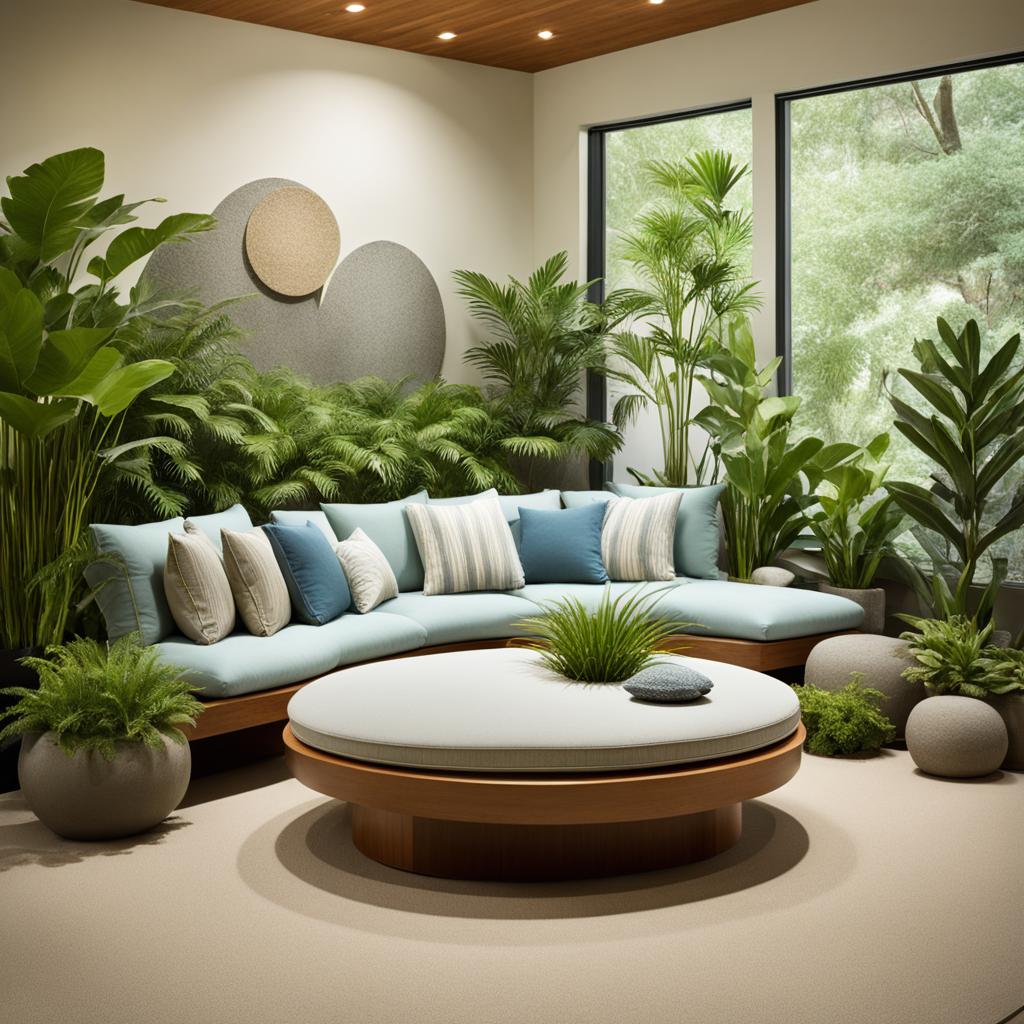
Creating a Physical and Mental Environment for Practice
Your tranquility temple should be quiet, comfy, and free from distractions. Important parts include:
| Element | Importance | Preference Rate |
|---|---|---|
| Soft lighting | Creates a calming atmosphere | 85% |
| Comfortable seating | Supports proper posture | 90% |
| Natural elements | Brings harmony | 80% |
| Personal touches | Adds a unique vibe | 75% |
Establishing Consistency in Your Meditation Routine
A dedicated stillness studio makes it easier to meditate regularly. Pick a set time for meditation in your quiet spot. This routine makes it simpler to keep up over time. Even small spaces can be powerful peace spots with the right setup and intention.
Choosing the Ideal Location for Your Meditation Room

Finding the perfect spot for your meditation room is key for a great practice. The right spot can change your experience, making any area a peaceful retreat. Look for places that are quiet and have few distractions.
Think about these things when picking your meditation spot:
- Noise levels: Choose a quiet corner away from busy areas
- Natural light: Go for a spot with windows for soft light
- Privacy: Make sure you can close the area for quiet sessions
- Size: Even a small spot can be a powerful place for relaxation
Your meditation space doesn’t have to be big. A 400-square-foot apartment can fit a special meditation area. Be creative with corners or unused spots to make your own sanctuary.
“The right environment can elevate your meditation practice, turning it into a transformative daily ritual.”
To make your space better, think about adding things like Ethel Studio zero-waste meditation cushions or an Ume handmade incense holder. These items can make your retreat more inviting for your daily practice.
Essential Elements of a Calming Meditation Space
Creating a peaceful spot in your home is crucial for inner calm. A well-thought-out zen space uses elements that touch your senses and help you relax. Let’s look at the key parts that turn a regular room into a place for mindfulness.
Lighting Considerations
Lighting sets the mood in your quiet corner. Soft, natural light is perfect for meditation. Try to place your meditation spot near a window if you can. For evening sessions, dimmable lamps or candles create a calming feel. Colors like blue and green are calming, say color experts.
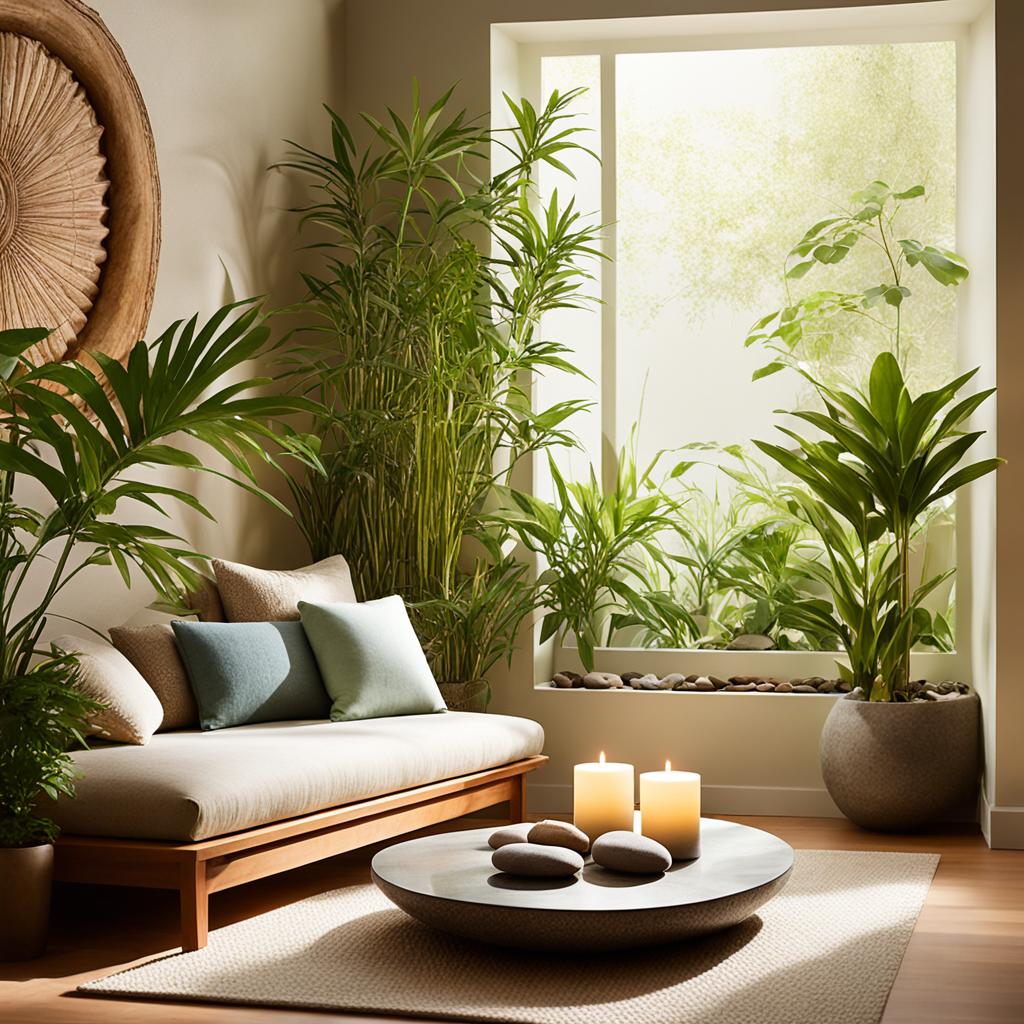
Comfortable Seating Options
Your meditation spot needs comfy seating for long meditation times. You can choose from cushions, benches, or ergonomic chairs. The Perfect Chair Recliner by Human Touch is great for easing back and neck pain during meditation.
Incorporating Natural Elements
Adding nature to your zen space brings harmony and balance. Plants, flowers, or a small water fountain can make your space better. These natural elements clean the air and help ground your meditation. Just 10 minutes with nature can lift your mood and cut stress.
| Element | Benefit | Examples |
|---|---|---|
| Aromatherapy | Stress relief, immune boost | Lavender, chamomile, peppermint |
| Sound | Focus, relaxation | Nature sounds, soft music |
| Natural decor | Harmony, grounding | Plants, sand, seashells |
Your meditation space should show your style but keep it simple to avoid distractions and deepen your practice.
Designing Your Meditation Room for Maximum Tranquility
Creating a calming oasis for meditation takes careful thought. Your inner peace sanctuary should show tranquility and encourage deep relaxation. Let’s look at key elements to make your space a serene retreat.
Selecting a Soothing Color Palette
Colors are key in setting your meditation room’s mood. Choose soft, muted tones that bring calmness. Pale colors like beige, eggshell, and blush are great choices. Earth tones such as rust orange or warm gray can ground your space. Navy blue adds depth without being overwhelming.
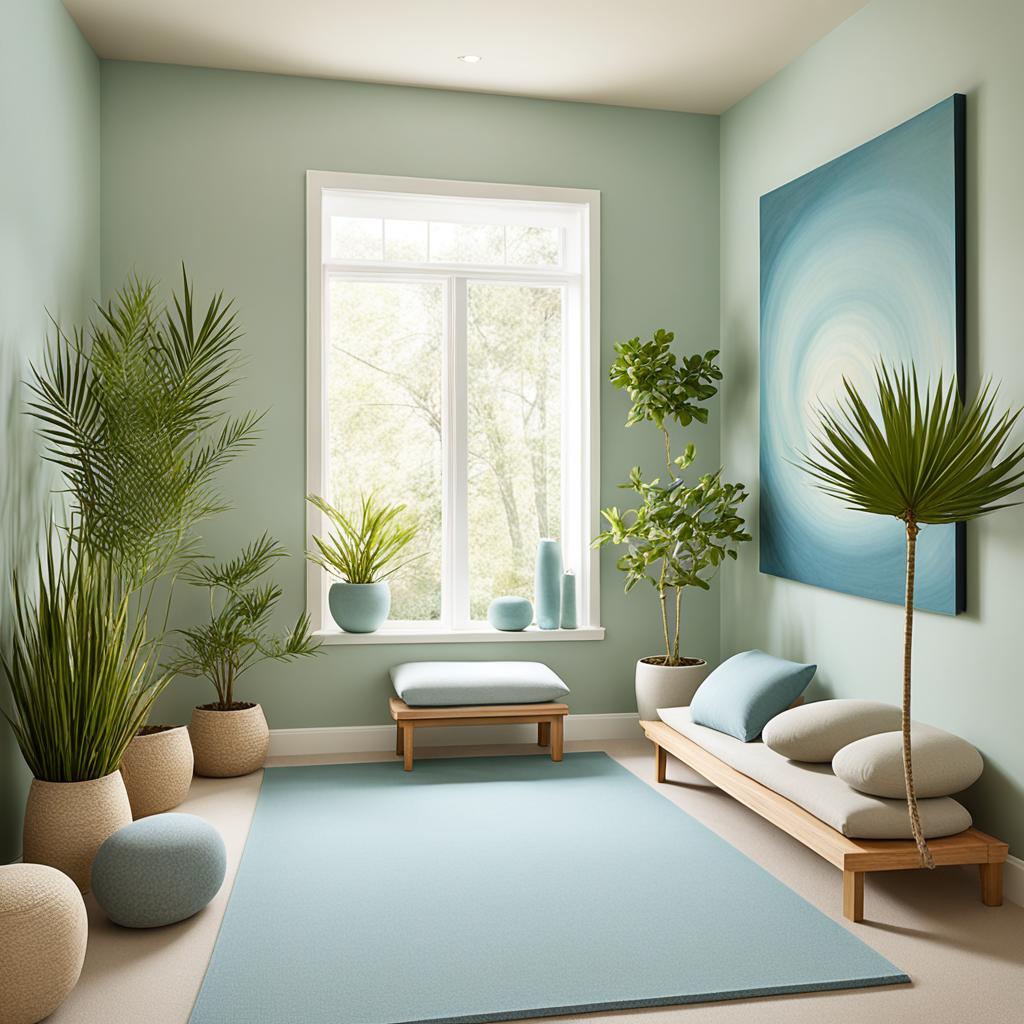
Minimizing Clutter and Distractions
A clutter-free space is essential for focus. Remove electronic devices and keep surfaces clean. Clutter increases stress hormones and hinders concentration. Choose simple, functional furniture for an open feel in your relaxation oasis.
Adding Personal Touches and Meaningful Decor
Make your serenity corner personal with items that mean something to you. Add natural elements like plants to purify air and boost creativity. Use soft fabrics for comfort. Include a small water feature or nature sounds for ambiance. Display inspiring artwork or quotes that reflect your practice.
| Element | Benefits | Examples |
|---|---|---|
| Plants | Air purification, stress reduction | Bamboo palm, peace lily |
| Fabrics | Comfort, warmth | Cotton, silk, chenille |
| Scents | Mood enhancement, relaxation | Lavender, eucalyptus, sage |
| Sounds | Tranquility, focus | Water features, wind chimes |
Remember, your meditation room should be inviting and peaceful. By choosing the right colors, minimizing distractions, and adding meaningful decor, you’ll create a space that supports your practice and brings inner calm.
Creating a Multi-Sensory Experience in Your Meditation Room
Turn your quiet space into a peaceful sanctuary by engaging all your senses. Using a multi-sensory approach can make your meditation practice more immersive. This can turn your relaxation nook into a special place.

Begin with aromatherapy to set the mood. Essential oils or incense can make the atmosphere calming. Lavender helps you relax, while citrus scents can boost your energy and focus.
Think about the look of your quiet zone next. Soft, ambient lighting or natural light can make it serene. Use dimmable lamps or candles to change the brightness as you like.
Texture is important too. Add plush cushions, soft rugs, or a comfy meditation chair to make your space more inviting.
Sound is key as well. A small water fountain or wind chimes can create a soothing background sound. Or, try meditation apps or guided sessions for a modern touch.
| Sense | Element | Benefits |
|---|---|---|
| Smell | Essential oils | Promotes relaxation, reduces stress |
| Sight | Soft lighting | Creates calming atmosphere |
| Touch | Plush cushions | Enhances physical comfort |
| Sound | Water fountain | Produces soothing background noise |
By designing a multi-sensory experience in your meditation room, you create a space that supports your practice. This leads to deeper relaxation and mindfulness.
Incorporating Technology to Enhance Your Practice
Technology can make your meditation room a high-tech peaceful haven. With smart devices and apps, you can make a stress-free oasis that meets your needs. Let’s see how technology can boost your mindfulness practice.
Using Meditation Apps and Guided Sessions
Meditation apps bring guided sessions right to you. They turn your tranquility chamber into a personalized stillness station. Apps like Headspace and Calm offer structured programs for a consistent practice.
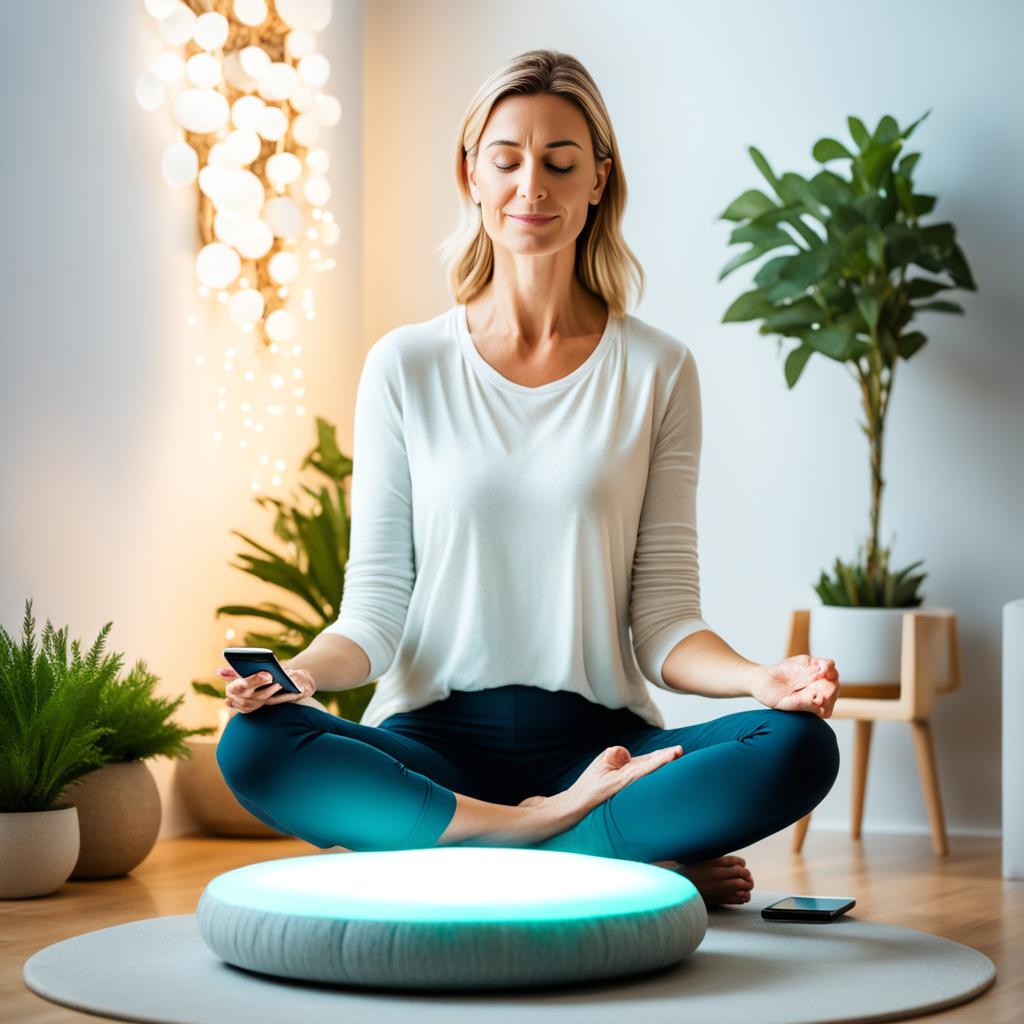
Implementing Sound Therapy and Music
Sound is key to a serene atmosphere. Smart speakers can fill your mindfulness sanctuary with nature sounds or calming music. Binaural beats and white noise generators can help you relax deeper.
Exploring Virtual Reality Meditation Experiences
Virtual reality (VR) takes you to peaceful places, making meditation better. VR headsets let you practice in virtual environments, like peaceful beaches or tranquil forests, right in your serenity nook.
| Technology | Benefits | Examples |
|---|---|---|
| Meditation Apps | Guided sessions, progress tracking | Headspace, Calm |
| Sound Therapy | Improved focus, stress reduction | Nature sounds, binaural beats |
| Virtual Reality | Immersive experiences, enhanced relaxation | Tripp, Guided Meditation VR |
By thoughtfully adding these technologies, you can make a dynamic and flexible meditation space. Remember, the aim is to improve your practice, not distract from it. Use tech tools to support your mindfulness journey and turn your space into a true tranquility chamber.
Maintaining and Evolving Your Meditation Room
Your zen corner is more than just a space; it’s a key part of your inner peace journey. Keep it fresh and inviting with regular care. A clean, clutter-free space helps you meditate better.
Change things up in your peace haven now and then. Swap out decor or add new objects to keep things interesting. This keeps your practice fresh and your space in line with your changing needs. Your peaceful retreat should grow with you.

Let the seasons change your inner peace space. Add cozy blankets for winter or cooling elements for summer. These changes keep your space inviting all year, making meditation more enjoyable.
“The physical environment affects the body and mind by rousing corresponding energies, either drawing attention outward or inward, activating or calming the mind, and vitalizing or draining the body.” – Adi Shankaracharya
Try new things in your space. Look into different seating, lighting, or natural elements. You might find that a meditation cushion helps your posture or soft lighting improves focus. Your perfect meditation room is always evolving, open to positive changes.
Meditation Room Ideas for Small Spaces and Shared Living Areas
You don’t need a big space to make a tranquility oasis. In fact, 75% of meditation room ideas for small spaces use nature-inspired decor. This helps create a calming corner. Let’s see how you can turn any small spot into your personal inner peace chamber.
Creating a Portable Meditation Kit
A portable meditation kit is great for small spaces. Put together a cushion, candle, and a small plant in a decorative box. This way, you can meditate anywhere, anytime. It’s a flexible option that 20% of people use to fit their meditation into any space.
Utilizing Multi-Purpose Furniture and Decor
Use items that do more than one thing to save space. A folding screen can give privacy in shared areas and also be art. Think about a storage ottoman that’s both seating and a place to keep your meditation stuff. In fact, 15% of meditation room ideas focus on smart storage to keep things tidy.
Maximizing Corner Spaces and Unused Areas
Turn often-missed spots into your own stillness zone. A cozy window seat or a small alcove can be your meditation spot. Use wall-mounted shelves for plants and calming decor. Remember, 60% of meditation room designs use natural light, so try to place your space near a window. With some creativity, even the tiniest corner can be your sanctuary for peace.
